Rosella facts for kids
Quick facts for kids Rosella |
|
|---|---|
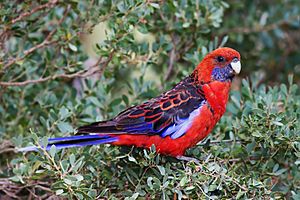 |
|
| Adult crimson rosella (P. elegans) | |
| Scientific classification |
|
| Kingdom: | Animalia |
| Phylum: | Chordata |
| Class: | Aves |
| Order: | Psittaciformes |
| Family: | Psittaculidae |
| Tribe: | Platycercini |
| Genus: | Platycercus Vigors, 1825 |
| Species | |
Rosellas are a group of very colourful parrots found in Australia. There are six main kinds, called species, and many more subspecies (which are like different types within a species). These birds belong to a group called Platycercus.
The name Platycercus means "broad-tailed" or "flat-tailed". This describes a special feature of rosellas and other parrots in their family. Rosellas mostly eat seeds and fruit.
Contents
What Are Rosellas?
Rosellas are medium-sized parrots with long tails. They range in size from about 26 to 37 centimeters (10 to 14.5 inches) long. The feathers on their backs often have a cool, scalloped pattern. This pattern and their bright colours help tell the different types apart.
All rosella species have unique patches of colour on their cheeks. Male and female rosellas usually look very similar. However, the western rosella is an exception, where males and females have slightly different colours. Young rosellas often have green feathers, which change as they grow older.
Where Do Rosellas Live?
Rosellas are originally from Australia and nearby islands. They live in forests, woodlands, farms, and even in parks and gardens in towns. You won't find them in the dry, open areas of the Australian outback.
Some rosellas have also been introduced to New Zealand and Norfolk Island. They now live freely in these places too.
Rosella Behaviour and Life Cycle
Rosellas mainly eat seeds and fruit. They often hold their food with their feet while they eat. These birds also love to bathe in puddles of water. They scratch their heads using their foot, reaching it from behind their wing.
Unlike some other birds, rosellas don't usually preen each other's feathers. Their courtship display, which is how they attract a mate, is quite simple. The male waves his tail from side to side and bobs his head. The female will do the same if she is interested.
Nesting and Reproduction
Like most parrots, rosellas build their nests in holes or hollows. They usually choose high spots in old, large trees in forested areas. A female rosella will lay several eggs. She sits on the eggs for about 21 days to keep them warm until they hatch.
During this time, the male rosella brings food to the female. He continues to feed her for a while after the chicks hatch. The baby chicks are born covered in soft white down. They are ready to leave the nest and fly after about five weeks.
Rosellas as Pets
Many people enjoy keeping the colourful rosella species as pets or in aviaries (large bird enclosures). They can live for more than 20 years! Rosellas are also known to be relatively easy to breed in captivity.
Some people say rosellas can be a bit aggressive towards other birds in captivity. Because of this, it's sometimes suggested to keep them separate. However, other bird owners find them to be very gentle and kind birds.
In captivity, rosellas eat a diet of seeds, fruits like apples, pears, and grapes, and vegetables such as lettuce and grass.
Types of Rosellas
There are six main species of rosellas. Here are some of them:
| Species | |||
|---|---|---|---|
| Common and scientific names | Picture | What they look like | Where they live |
| Western rosella (Platycercus icterotis) |
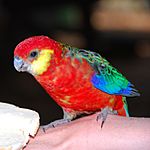 |
About 26 cm (10 inches) long, this is the smallest rosella. Males are mostly red with yellow cheeks. Females are duller, often green with a reddish forehead. | Southwest Australia |
| Crimson rosella (Platycercus elegans) |
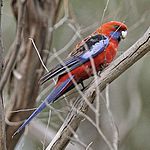 |
About 36 cm (14 inches) long. Most are bright red, but some types can be yellow or a mix of red, orange, and yellow. | East and Southeast Australia |
| Green rosella (Platycercus caledonicus) |
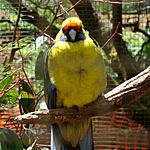 |
About 37 cm (14.5 inches) long, this is the largest rosella. It has a yellow head with blue cheeks and a red band above its beak. | Tasmania |
| Pale-headed rosella (Platycercus adscitus) |
 |
About 30 cm (12 inches) long. Mostly blue, but with a cream-yellow head and upper chest. | Eastern Australia |
| Eastern rosella (Platycercus eximius) |
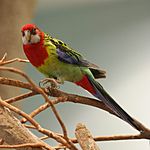 |
About 30 cm (12 inches) long. Has a red head and white cheeks. Its back feathers are black with yellow or green edges. | Australia and Tasmania. Also found in New Zealand. |
| Northern rosella (Platycercus venustus) |
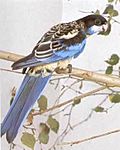 |
About 28 cm (11 inches) long. Has a black forehead and crown with white-on-blue cheek patches. Its belly and chest are pale yellow with black edges. | Northern Australia, from the Gulf of Carpentaria to the Kimberleys. |
Images for kids
-
Green rosella in Tasmania. It is the largest rosella at 37 cm (14.5 in) long.
See also
 In Spanish: Pericos de cola ancha para niños
In Spanish: Pericos de cola ancha para niños



